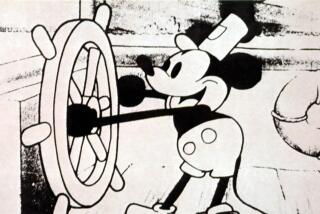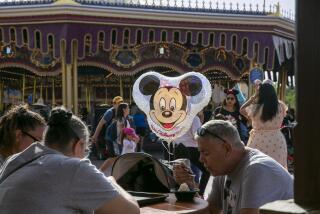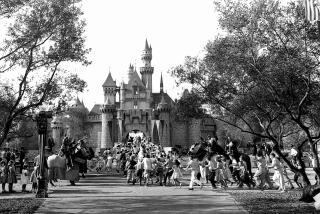MICE CARTOON BORN IN THE SILENT ERA
- Share via
Animators began using cartoon mice during the early days of the medium, and have drawn them ever since, apparently from force of habit. Swarms of virtually identical mice infested the silent cartoons--especially Paul Terry’s “Aesop’s Fables.” Everybody copied the Terry mice, even Walt Disney. (Ignatz in George Herriman’s comic strip, “Krazy Kat,” seems to have been the prototype for these pointy-nosed little rodents.)
“Steamboat Willie” introduced the sound cartoon and Mickey Mouse to audiences in 1928. He quickly became the most popular cartoon character ever. Queen Mary of England, the Nizam of Hyderabad and Benito Mussolini were among his fans. Adolf Hitler cast one of the few dissenting votes: Nazi propaganda excoriated Mickey, proclaiming that “mice are dirty.” Mickey’s unprecedented success led to another spate of mouse characters, including some shameless Mickey impersonators. (During the early ‘30s, the mice in the Van Buren cartoons were so close to Mickey and Minnie that Disney took them to court.)
Other mouse stars came later: Timothy in “Dumbo” and Terrytoon’s Mighty Mouse. MGM’s Tom and Jerry spawned another rash of imitators, including Herman and Katnip and Little Roquefort. Speedy Gonzalez and his cousin, Slowpoke Rodriguez, won an Oscar for Warner Bros.
The ‘50s and ‘60s brought Pixie and Dixie and Blabbermouse; Mush Mouse; Hashimoto and the 2,000-Year-Old Mouse; Gus and Jaq in “Cinderella” and the “Monstrous Metal-Munching Moon Mice” that invaded Earth in a “Rocky and Bullwinkle” adventure.
More to Read
The biggest entertainment stories
Get our big stories about Hollywood, film, television, music, arts, culture and more right in your inbox as soon as they publish.
You may occasionally receive promotional content from the Los Angeles Times.










